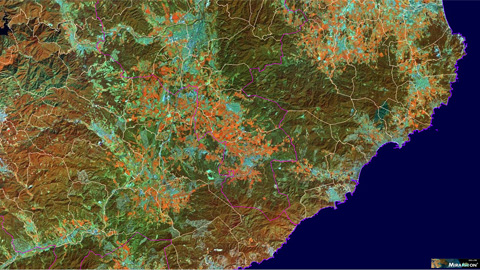Satellite images reveal how Iberian Peninsula forests have changed in the past 25 years

18/12/2017
The species and types of plant communities change due to both the physical characteristics of the terrain and the climatic or human factors. A study conducted by researchers at the UAB and the CREAF and published recently in Forest Ecology and Management shows the dynamics and evolution of vegetation in three large regions of the Iberian Peninsula during the years 1987 and 2012. The article establishes that "after the abandonment of many rural areas and a change in the use of land, drought and topographical variables conditioning the availability of water, such as altitude, slope, soil humidity and solar radiation, play an important role in the changes occurring in forests in these past years", says lead author of the study and UAB researcher Juan José Vidal Macua. The article highlights a decrease in conifers (especially pine trees) and the expansion of Mediterranean flat-leaved trees, such as holm oaks and oaks, which could become the dominant trees in many areas of the Mediterranean if the climatic tendency of temperature rises and scarcity in water continues.
The use of remote sensing and statistics in the models of global change
“Identifying trends at regional and global levels and the effects of climate change on plants requires the management of large amounts of data. Until now, the use of aerial images have allowed researchers to advance greatly, but remote sensing with satellites is the best tool with which to identify trends in the dynamics of plants at large temporal and spatial levels", explains Xavier Pons, professor in Geography at the UAB, CREAF researcher and director of the study. The research forms part of the ACAPI project which is studying the dynamics of soil coverage and climate of the Iberian Peninsula in the past 45-65 years.
In order to discover the trends in changes in the peninsula's forests, three Iberian regions were analysed in the study. The study was conducted with Landsat satellite images, a database on droughts in the Iberian Peninsula (calculated thanks to the climate models of UAB lecturer Miquel Ninyerola), an elevated number of different environmental variables and computational statistics. Two areas are located in the north-eastern part of the peninsula: one includes a large portion of Catalonia and the other Aragon, with a slight superposition (given that there is a coincidence in the scenes from the satellite's orbit), and both of them reach the Pyrenees. The third area is located in Andalusia and includes the Sierra Nevada and a good part of the Penibetic system.
Decrease in Conifers Gives Way to More Flat-Leaved Trees
In general, conifers are highly affected by long periods of droughts and that is why species such as Scots pine, better adapted to colder latitudes of northern Europe, can be found in humid areas and high mountain altitudes. That creates favourable conditions for certain flat-leaved trees such as holm, kermes and downy oak. In fact, results show that under drought conditions, it is easier for forests containing a mixture of flat-leaved trees and conifers to become flat-leaved forests in the future. At the same time, in areas which do not suffer frequent droughts, there are conifers which maintain very active dynamics, especially the Aleppo pine, which is capable of competing with holm oak at the lowest Mediterranean altitudes.
In the northern areas of Catalonia and Aragon, holm and kermes oak are in favourable positions in areas most affected by droughts. This happens in both mature forests and in sub shrub formations, thanks to the fact that these flat-leaved trees are better adapted to a scarcity of water. In areas of Catalonia with low solar radiation, droughts favour deciduous flat-leaved trees such as downy oak in spaces shared with Scots pine, which is less adapted to a deficit in water.
Nevertheless, the transition areas into deciduous forests generally need water and humidity in soil, and that is why they are more frequent in the north of the peninsula, and less visible in the south, where the climate is rather warmer and drier. Deciduous trees such as oaks and beech dominate transition areas above 1000 metres and especially on the northern slopes where there is more humidity. In Aragon, the area of the Cinca River has undergone an important transition from conifers to deciduous trees, given that the riverbed soil is much more adequate for deciduous trees.
There is a need to take into account that “the historical management of the territory, the abandonment of the land and the substitution of firewood for fossil fuels as a source of energy have also contributed to the expansion of flat-leaved trees”, explains one of the study's authors and UAB and CREAF researcher Cristina Domingo. And she warns: “the fact that forests are changing and more drought-resistant species end up dominating the forest communities could alter the rhythm of the Mediterranean's carbon capture and fire regime”.
Original article:
Vidal-Macua J.J., Ninyerola M., Zabala A., Domingo-Marimon C., Pons X. (2017). Factors affecting forest dynamics in the Iberian Peninsula from 1987 to 2012. The role of topography and drought. Forest Ecology and Management, 406: pp 290-306. DOI: 10.1016/j.foreco.2017.10.011